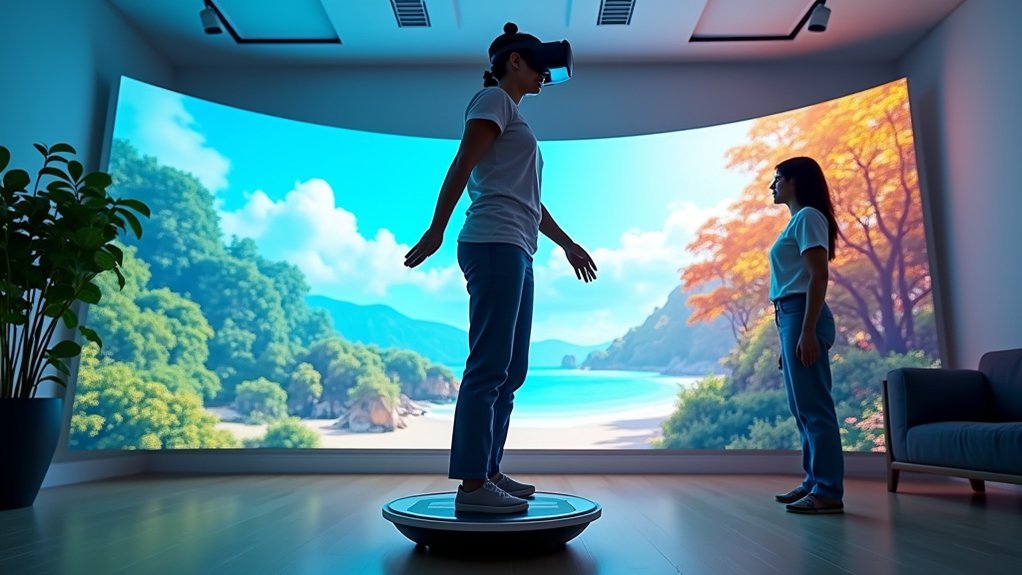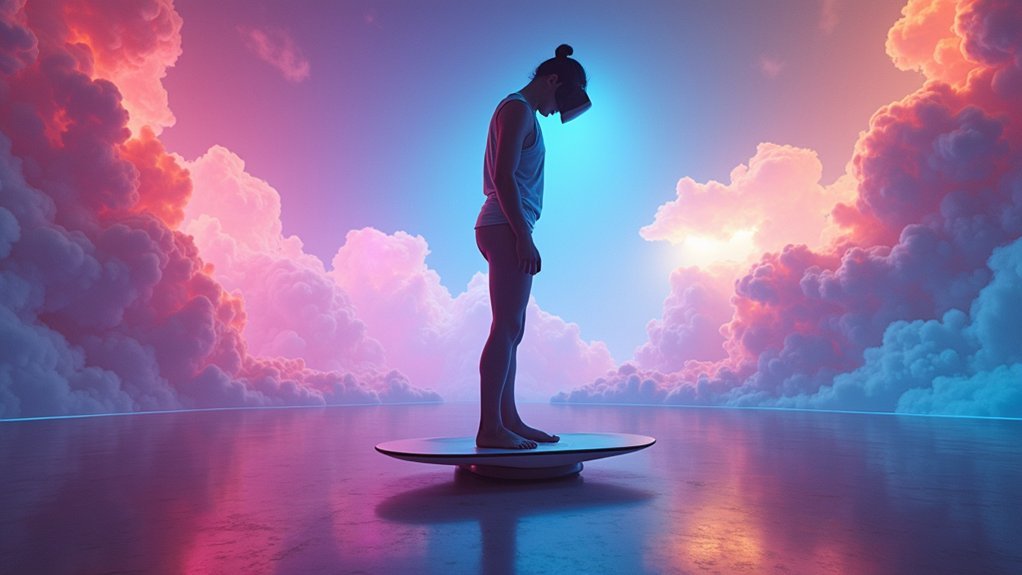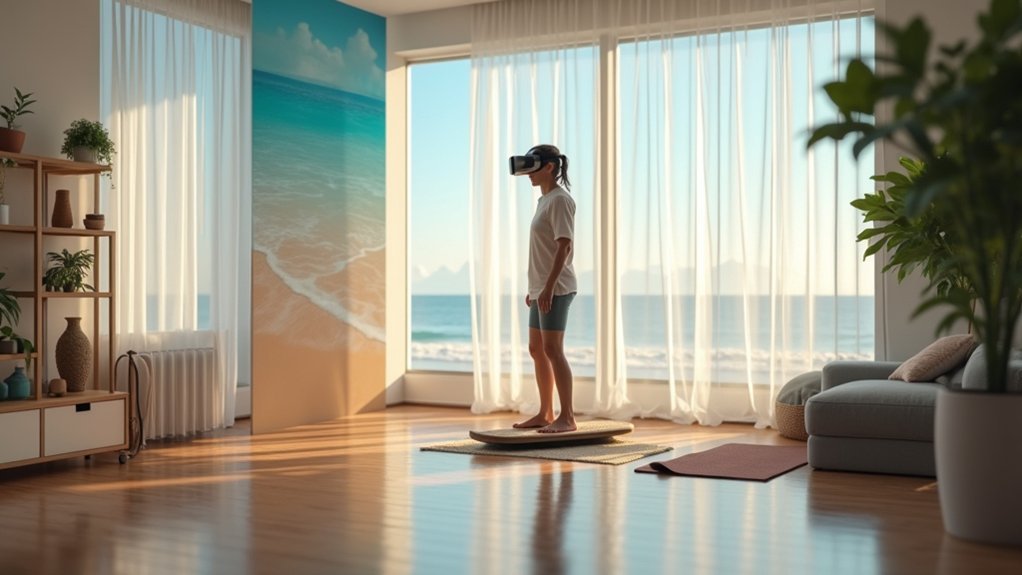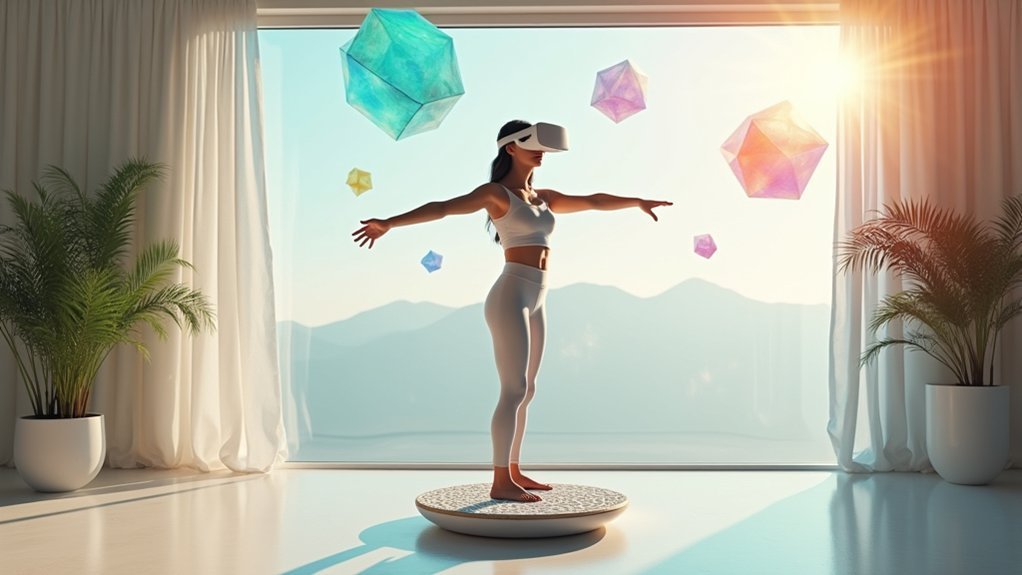Virtual reality enhances balance rehabilitation through immersive, interactive exercises that provide real-time feedback while you train. You’ll benefit from customizable environments tailored to your specific mobility needs, whether you have Parkinson’s, MS, or general balance issues. VR activates key muscle groups, improves posture, and enables safe practice of challenging movements. The technology works effectively at home or in clinical settings, often matching traditional therapy results with higher adherence rates. Explore how this technology might transform your balance recovery journey.
Balance Rehabilitation Through Virtual Reality Gaming

While traditional balance therapy often suffers from low patient engagement, virtual reality gaming has emerged as a revolutionary approach to balance rehabilitation.
You’ll benefit from immersive environments that greatly improve balance through interactive exercises like lunges and single leg extensions.
VR systems like Wii Fit provide stable yet challenging platforms for 45-minute training sessions multiple times weekly. These technologies offer real-time feedback, helping you immediately correct balance errors while measuring progress through standardized tests.
Whether you’re an elderly individual, someone with paraplegia, or recovering from an injury, VR gaming can boost your confidence in physical activities.
The portable, customizable nature of these systems means you can practice in various settings, including your home, making balance rehabilitation more accessible and effective than ever.
Studies show that VR-based exercise significantly improves scores on the Berg Balance Scale and other functional measures compared to conventional therapy approaches.
VR-Based Strategies for Balance Improvement in Neurological Conditions
For individuals with neurological conditions, virtual reality presents transformative strategies to improve balance beyond traditional rehabilitation approaches.
Whether you have Parkinson’s disease, multiple sclerosis, or traumatic brain injury, VR offers multi-sensory feedback through controlled environments that enhance engagement and motivation.
Immersive VR provides tailored sensory feedback for neurological conditions, boosting rehabilitation engagement when you need it most.
In Parkinson’s disease, VR shows immediate balance improvements comparable to conventional therapy while potentially enhancing neuroplasticity.
For MS patients, VR-based interventions often outperform traditional rehabilitation, with exergaming providing significant psychological and physical benefits.
The customizable nature of VR environments allows therapists to tailor challenges to your specific needs while maintaining safety.
The cost-effectiveness and accessibility of VR make it particularly valuable for home-based rehabilitation, allowing you to practice consistently with precise progress tracking throughout your recovery journey. The systematic review found that VR shows the greatest potential when combined with conventional rehabilitation methods rather than used alone.
Biomechanical Benefits of Virtual Reality Balance Training

The biomechanical impact of virtual reality balance training extends far beyond simply feeling more stable—it fundamentally alters how your body moves and responds to balance challenges.
When you engage in VR exercises, you’ll naturally increase trunk and hip flexion while activating essential knee extensor muscles that support stability.
Your training naturally shifts weight distribution to your supporting leg, mimicking real-world situations like skateboarding.
Advanced motion capture systems and electromyography precisely measure your joint movements and muscle activity, allowing for targeted improvements.
What makes VR particularly effective is its ability to provide a safe environment for practicing challenging movements while collecting biomechanical data for training optimization.
The resulting improvements in posture and muscle coordination create lasting benefits that transfer directly to everyday activities.
This immersive approach has shown effectiveness in reducing fall risk among older adults, addressing a critical health concern for the aging population.
Personalized VR Balance Programs for Different Mobility Levels
Personalized virtual reality balance training shines brightest when tailored to your specific mobility level, regardless of whether you’re recovering from injury or managing age-related stability challenges.
These systems excel at meeting you where you are—offering appropriate challenges whether you’re high-risk for falls or dealing with neurological conditions.
Virtual reality balance training adapts to your needs, whether you’re fall-prone or managing neurological issues.
You’ll benefit from individualized programs that provide realistic feedback while tracking your progress. The dynamic exercises gradually increase in difficulty as you improve, allowing you to advance at your own pace.
For those with severe mobility limitations, VR creates safe environments where you can practice balance without fear of falling. Recent research demonstrates that VR interventions may significantly improve mobility smoothness in individuals with Parkinson’s disease.
The technology’s versatility means you can access effective training in clinical settings or at home, making consistent practice possible regardless of your circumstances or mobility constraints.
Integrating VR Balance Exercises Into Home Rehabilitation Routines

Taking the personalized approach from clinical settings into your own living space, integrating virtual reality balance exercises at home represents a significant advancement in rehabilitation accessibility. You’ll find VR systems offer both convenience and engagement while complementing your existing physical therapy routines.
| Home Integration Feature | Benefit to You |
|---|---|
| Telerehabilitation options | Equal effectiveness to in-clinic treatments |
| Adaptive difficulty levels | Continuous challenge as you improve |
| Pre-set training programs | Easy start without technical expertise |
| Interactive exercises | Higher long-term adherence rates |
Despite initial setup costs, home-based VR can reduce expenses over time. You can schedule sessions that fit your daily routine, and the interactive nature of VR helps maintain your engagement far better than traditional exercises—making consistency less of a challenge.
Frequently Asked Questions
Does VR Balance Training Cause Motion Sickness in Elderly Users?
VR balance training can cause motion sickness in elderly users, but you’ll typically adapt within 15-20 minutes. You can reduce symptoms through gradual exposure and shorter initial sessions as your body adjusts.
How Expensive Is VR Equipment Compared to Traditional Balance Rehabilitation Tools?
You’ll face higher upfront costs with VR equipment ($100,000+) compared to traditional balance tools. However, VR becomes more cost-effective long-term due to minimal recurring expenses and better per-participant value over multiple uses.
Can VR Balance Training Be Effective for Wheelchair Users?
Yes, you’ll benefit from VR balance training as a wheelchair user. It effectively improves your sitting balance, offers engaging exercises, and can be adapted to your specific needs. You’ll likely find it satisfying and accessible.
What Insurance Coverage Exists for VR Balance Rehabilitation Therapy?
Insurance coverage for VR balance rehabilitation varies by provider. You’ll find most insurers require medical necessity documentation. Your therapist can bill using standard therapy CPT codes, though reimbursement processes aren’t fully standardized yet.
Are There Cultural Barriers to VR Technology Adoption for Balance Training?
Yes, you’ll face barriers like high costs, limited access, language differences, varying tech literacy, and cultural attitudes toward technology. VR systems often lack culturally-diverse content that would make training more relatable across different communities.
In Summary
You’ll find that virtual reality provides multifaceted solutions for improving your balance. It offers engaging games for rehabilitation, specialized strategies for neurological conditions, and biomechanical benefits through targeted training. Whether you’re seeking personalized programs for your mobility level or convenient home-based options, VR technology can transform your balance recovery journey with interactive, measurable, and adaptable exercises that you’ll actually want to complete.





Leave a Reply